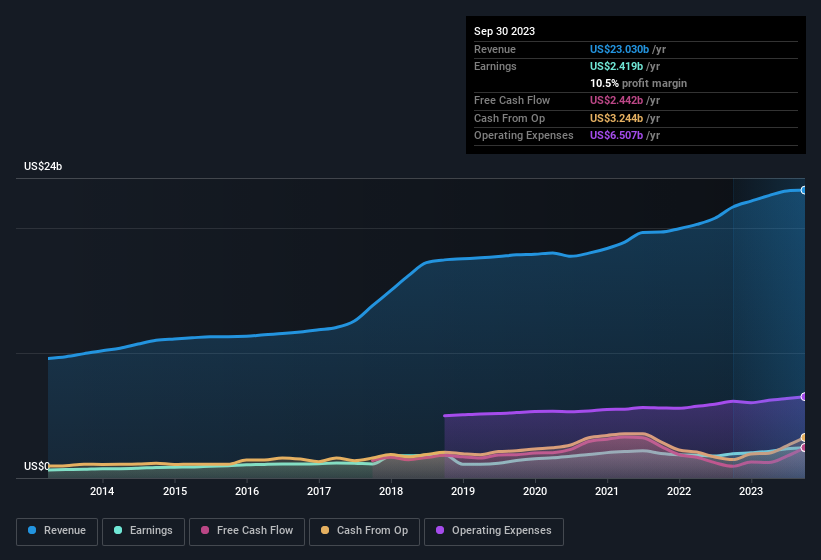With EPS Growth And More, Sherwin-Williams (NYSE:SHW) Makes An Interesting Case
Investors are often guided by the idea of discovering 'the next big thing', even if that means buying 'story stocks' without any revenue, let alone profit. But the reality is that when a company loses money each year, for long enough, its investors will usually take their share of those losses. Loss making companies can act like a sponge for capital - so investors should be cautious that they're not throwing good money after bad.
Despite being in the age of tech-stock blue-sky investing, many investors still adopt a more traditional strategy; buying shares in profitable companies like Sherwin-Williams (NYSE:SHW). Now this is not to say that the company presents the best investment opportunity around, but profitability is a key component to success in business.
Check out our latest analysis for Sherwin-Williams
How Fast Is Sherwin-Williams Growing?
The market is a voting machine in the short term, but a weighing machine in the long term, so you'd expect share price to follow earnings per share (EPS) outcomes eventually. So it makes sense that experienced investors pay close attention to company EPS when undertaking investment research. Over the last three years, Sherwin-Williams has grown EPS by 11% per year. That growth rate is fairly good, assuming the company can keep it up.
Top-line growth is a great indicator that growth is sustainable, and combined with a high earnings before interest and taxation (EBIT) margin, it's a great way for a company to maintain a competitive advantage in the market. The music to the ears of Sherwin-Williams shareholders is that EBIT margins have grown from 13% to 16% in the last 12 months and revenues are on an upwards trend as well. Both of which are great metrics to check off for potential growth.
In the chart below, you can see how the company has grown earnings and revenue, over time. For finer detail, click on the image.
While we live in the present moment, there's little doubt that the future matters most in the investment decision process. So why not check this interactive chart depicting future EPS estimates, for Sherwin-Williams?
Are Sherwin-Williams Insiders Aligned With All Shareholders?
Insider interest in a company always sparks a bit of intrigue and many investors are on the lookout for companies where insiders are putting their money where their mouth is. This view is based on the possibility that stock purchases signal bullishness on behalf of the buyer. However, insiders are sometimes wrong, and we don't know the exact thinking behind their acquisitions.
Insider selling of Sherwin-Williams shares was insignificant compared to the one buyer, over the last twelve months. Specifically the Executive Chairman, John Morikis, spent US$1.0m, paying about US$232 per share. That certainly piques our interest.
Along with the insider buying, another encouraging sign for Sherwin-Williams is that insiders, as a group, have a considerable shareholding. Notably, they have an enviable stake in the company, worth US$217m. While that is a lot of skin in the game, we note this holding only totals to 0.3% of the business, which is a result of the company being so large. So despite their percentage holding being low, company management still have plenty of reasons to deliver the best outcomes for investors.
While insiders already own a significant amount of shares, and they have been buying more, the good news for ordinary shareholders does not stop there. The cherry on top is that the CEO, Heidi Petz is paid comparatively modestly to CEOs at similar sized companies. For companies with market capitalisations over US$8.0b, like Sherwin-Williams, the median CEO pay is around US$12m.
The Sherwin-Williams CEO received total compensation of just US$3.5m in the year to December 2022. That's clearly well below average, so at a glance that arrangement seems generous to shareholders and points to a modest remuneration culture. CEO remuneration levels are not the most important metric for investors, but when the pay is modest, that does support enhanced alignment between the CEO and the ordinary shareholders. It can also be a sign of good governance, more generally.
Should You Add Sherwin-Williams To Your Watchlist?
One important encouraging feature of Sherwin-Williams is that it is growing profits. Better yet, insiders are significant shareholders, and have been buying more shares. These factors alone make the company an interesting prospect for your watchlist, as well as continuing research. You should always think about risks though. Case in point, we've spotted 1 warning sign for Sherwin-Williams you should be aware of.
Keen growth investors love to see insider buying. Thankfully, Sherwin-Williams isn't the only one. You can see a a curated list of companies which have exhibited consistent growth accompanied by recent insider buying.
Please note the insider transactions discussed in this article refer to reportable transactions in the relevant jurisdiction.
Have feedback on this article? Concerned about the content? Get in touch with us directly. Alternatively, email editorial-team (at) simplywallst.com.
This article by Simply Wall St is general in nature. We provide commentary based on historical data and analyst forecasts only using an unbiased methodology and our articles are not intended to be financial advice. It does not constitute a recommendation to buy or sell any stock, and does not take account of your objectives, or your financial situation. We aim to bring you long-term focused analysis driven by fundamental data. Note that our analysis may not factor in the latest price-sensitive company announcements or qualitative material. Simply Wall St has no position in any stocks mentioned.

 Yahoo Finance
Yahoo Finance 
